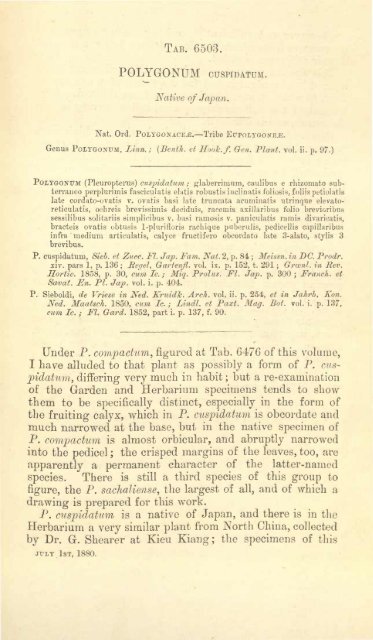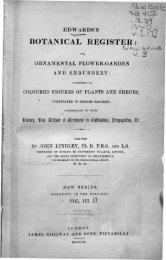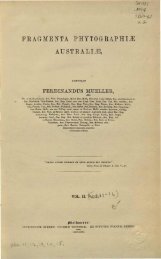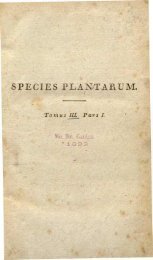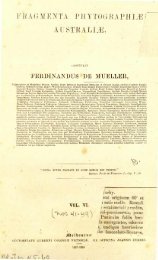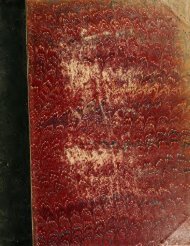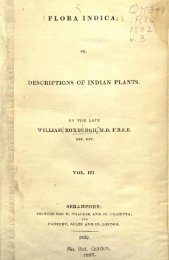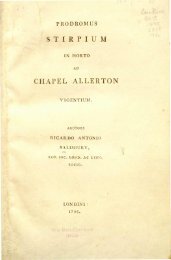Botanical Magazine 106 - 1880.pdf - hibiscus.org
Botanical Magazine 106 - 1880.pdf - hibiscus.org
Botanical Magazine 106 - 1880.pdf - hibiscus.org
Create successful ePaper yourself
Turn your PDF publications into a flip-book with our unique Google optimized e-Paper software.
TAB. 6503.<br />
POLYGONUM CUSPIDATUM.<br />
Native of Japan.<br />
Nat. Ord. POLYGONACE/E.•Tribe EüPOLYGONE^E.<br />
Genus POLYGONTTM, Zinn.; {Beruh, et Hook.f. Gen. Plant, vol. ii. p. 97.)<br />
POLYGONUM (Pleuropterus) cuspidatum ; glaberrimum, caulibus e rhizomato sub-<br />
terráneo perplurimis fasciculatis elatis robustis inclinatis foliosis, foliis petiolatis<br />
late cordato-ovatis v. ovatis basi late truncata acurainatis utrinque elevato-<br />
reticulatis, oehreis brevissimis deciduis, racemis axillaribus folio brevioribus<br />
sessilibus solitariis simplieibus v. basi ramosis v. paniculatis ramis divarieatis,<br />
bracteis ovatis obtusis 1-plurifloris rachique puberulis, pedicellis capillaribus<br />
infra medium articulatis, calyce fructifère obcordato late 3-alato, stylis 3<br />
brevibus.<br />
P. cuspidatum, Sieb, et Zuce. Fl. Jap. Farn. Nat. 2, p. 84 ; Meissn. in DC. Prodr.<br />
xiv. pars 1, p. 136 ; Regel, Gartenfl. vol. ix. p. 152, t. 291 ; Groenl. in Rev.<br />
Sortie. 1858, p. 30, cumie.; Miq. Prolus. Fl. Jap. p. 300; Franck, et<br />
Savat. En. PI. Jap. vol. i. p. 404.<br />
P. Sieboldi, de Vriese in Ned. Kruidk. Arch. vol. ii. p. 254, et in Jahrb. Kon.<br />
Ned. Maatsch. 1850, cum Ic. ; Lindl. et Paxt. Mag. Bot. vol. i. p. 137,<br />
cum Ic. ; Fl. Gard. 1852, part i. p. 137, f. 90.<br />
Under P. compaction, figured at Tab. 6476 of this volume,<br />
I have alluded to that plant as possibly a form of P. cus-<br />
pidatum, differing very much in habit ; but a re-examination<br />
of the Garden and Herbarium specimens tends to show<br />
them to be specifically distinct, especially in the form of<br />
the fruiting calyx, which in P. cuspidatum is obcordate and<br />
much narrowed at the base, but in the native specimen of<br />
P. compactum is almost orbicular, and abruptly narrowed<br />
into the pedicel ; the crisped margins of the leaves, too, are<br />
apparently a permanent character of the latter-named<br />
species. There is still a third species of this group to<br />
figure, the P. sachaliense, the largest of all, and of which a<br />
drawing is prepared for this work.<br />
P. cuspidatum is a native of Japan, and there is in the<br />
Herbarium a very similar plant from North China, collected<br />
by Dr. G. Shearer at Kieu Kiang; the specimens of this<br />
JULY 1ST, 1880.


